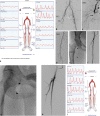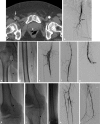Acute Limb Ischemia Therapies: When and How to Treat Endovascularly
- PMID: 30728661
- PMCID: PMC6363543
- DOI: 10.1055/s-0038-1676321
Acute Limb Ischemia Therapies: When and How to Treat Endovascularly
Abstract
Acute limb ischemia is an emergent limb and life-threatening condition with high morbidity and mortality. An understanding of the presentation, clinical evaluation, and initial workup, including noninvasive imaging evaluation, is critical to determine an appropriate management strategy. Modern series have shown endovascular revascularization for acute limb ischemia to be safe and effective with success rates approaching surgical series and with similar, or even decreased, perioperative morbidity and mortality. A thorough understanding of endovascular techniques, associated pharmacology, and perioperative care is paramount to the endovascular management of patients presenting with acute limb ischemia. This article discusses the diagnosis and strategies for endovascular treatment of acute limb ischemia.
Keywords: acute limb ischemia; endovascular; interventional radiology; thrombectomy; thrombolysis.
Figures


References
-
- Creager M A, Kaufman J A, Conte M S. Clinical practice. Acute limb ischemia. N Engl J Med. 2012;366(23):2198–2206. - PubMed
-
- Gilliland C, Shah J, Martin J G, Miller M J., Jr Acute limb ischemia. Tech Vasc Interv Radiol. 2017;20(04):274–280. - PubMed
-
- Patel N H, Krishnamurthy V N, Kim S et al.Quality improvement guidelines for percutaneous management of acute lower-extremity ischemia. J Vasc Interv Radiol. 2013;24(01):3–15. - PubMed
-
- Lukasiewicz A, Lichota W, Thews M. Outcomes of accelerated catheter-directed thrombolysis in patients with acute arterial thrombosis. Vasc Med. 2016;21(05):453–458. - PubMed

